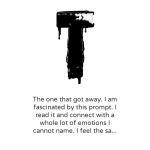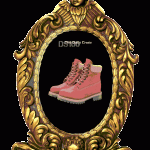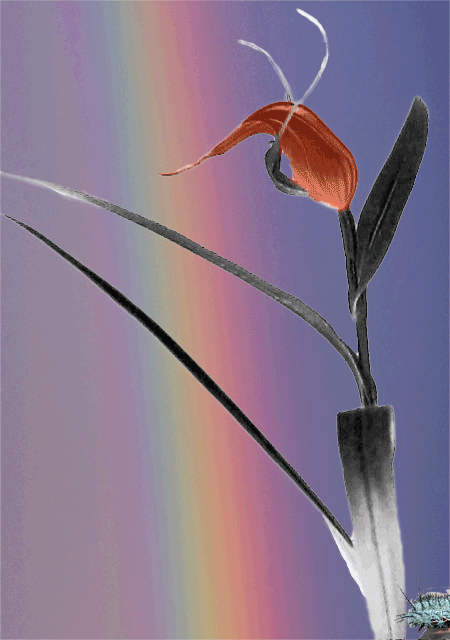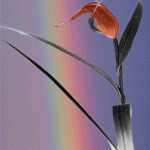A writing Daily Create based on the Art Assignment prompt: “The one that got away”.
Month: November 2014
This was fun!
Daily create today asked for a shoefie for Howard and I decided to do it.
Yesterday’s daily create prompted us to reflect on ‘the one that got away’ and I struggled with the prompt for all sorts of reasons.
Today I put the two creates together.
A few years ago, when I was too old (according to whom?) to buy pink Timberlands, I bought a pair. I loved these shoes so much, but I rarely wore them. I was worried that people would think I was just ‘too old’ to wear such shoes.
They stayed in their box for a long time. One day a friend was searching for a pair of shoes for his daughter and we happened to be the same size. I gave them away.
I still miss them.
So my pink Timberlands are the ones that got away and also my ‘shoefie’ for today. I wanted to add a flavour of the ‘worst possible taste’ which we also had on the Daily Create this week with our worst album covers remixes. I searched for the ugliest frame I could find to add to my creation. Voila! 3 Daily Creates in 1:
“The worst ‘shoefie’ of the pair that got away”
For howardrheingold
Rainbow Flower Power – take 3 for GIFFight and Gif it Up
Flower source image from the Museum of New Zealand
Background image “Rainbow” by Evan Leeson by-nc-sa 2.0 https://flic.kr/p/eovqWK
“radioactive” turquoise caterpillar GIF (CC-By-SA) courtesy of Alan Levine (@cogdog)
Art on the couch critique
What strikes me on first seeing this lovely gif are the changing colours of the flower which pick up the background rainbow colours. The lines of the rainbow flow in the same upward direction as the flower and complement it. I notice the colours as they seem other-worldly and contrast strongly with the neutral flower stem and leaves. The rainbow adds depth to the composition. As your eye is drawn to the changing colours in the flower and the rainbow, the caterpillar surprises you and appears to create balance. A 3-way attention point: Rainbow, flower, caterpillar against the neutral stem. The fine threads in grey around the flower add contrast in stillness as the flower inside bursts with life.
The movement of the caterpillar seems important and adds realism to an otherwise ethereal composition. What gives it the ethereal quality may be that the colours chosen by the artist do not exist in nature. We recognise a flower and a caterpillar yet the colours do not belong. It seems as if the natural elements put a barrier up for the viewer, we cannot reach the end of the rainbow. This effect is added to by the blurry nature of the rainbow. Then there is the creation of depth by the caterpillar appearing in the corner and seeming to go ‘into’ the picture nearest to the viewer. This makes it seem like the flower is behind the caterpillar and this in turn adds to the sense of the rainbow being unreachable.
Given the title one assumes the choice of colour was intended to give the composition a pop-art style. The flower is out of any context, there are no frames to locate the work, adding to its detached feel. I imagine it as a flower that would belong in a biosphere 2 experiment of the future or a science fiction movie. My alternative title: ‘Life thrives anywhere’.
Creative commons licensed (BY-NC-SA) flickr photo by troutcolor: http://flickr.com/photos/troutcolor/15719237262
What stood out when I first saw it was the texture of the sky and the position of the sky, it is in the ‘wrong’ place. Also, the bright red in the middle and the sharp blue beyond the could – great contrast. The main reason this strikes the viewer is contrast between the colours and the conflict between where we know the sky to be and where it is positioned in the photo. What stands out is that whilst we know there is water there, we cannot see water, only sky and ships that ‘should’ be on the water. The mind is confused.
The colour of the clouds – pinky red. Fluffy, makes me want to touch them and this seem important as it gives texture to the photo. The top/bottom positioning is inverted and this draws the attention in. A key contrast seems the bright red dot in the mostly blue photo.
Depth works in a mysterious way to my untrained eye. I see the cloud close to me, land further way and then I see sky even further away. This is not how looking at a scene like this in real life would look – so you are pulled in to resolve the conflict between the ‘seen’ and the ‘real’. It has a surreal feel to it and yet a warmth from the lovely fluffy clouds.
What is not obvious is where the photo was taken from. No sense of the photographer or what is around him.
As I look at the photo I feel detachment, a sense of perspective and a sense of my givens being challenged. Literally and metaphorically – the sky does not belong down below and yet my eyes deceive me. My rigid views challenged as I have to stop and take a second look. I would call it ‘The impossible sky’.
I keep want it to edit the photo and remove the rail at the bottom. I might do that at some point to understand what is making me want to do it.
If you want to know more about this Art on the Couch project, you can read my first post or click on the hashtag to see all the post on this blog relating to it.
There are no Commandments in art and no easy axioms for art appreciation. “Do I like this?” is the question anyone should ask themselves at the moment of confrontation with the picture. But if “yes,” why “yes”? and if “no,” why “no”? The obvious direct emotional response is never simple, and ninety-nine times out of a hundred, the “yes” or “no” has nothing at all to do with the picture in its own right.
“I don’t understand this poem”
“I never listen to classical music”
“I don’t like this picture”
are common enough statements but not ones that tell us anything about books, painting, or music. They are statements that tell us something about the speaker. That should be obvious, but in fact, such statements are offered as criticisms of art, as evidence against, not least because the ignorant, the lazy, or the plain confused are not likely to want to admit themselves as such. We hear a lot about the arrogance of the artist but nothing about the arrogance of the audience. The audience, who have not done the work, who have not taken any risks, whose life and livelihood are not bound up at every moment with what they are making, who have given no thought to the medium or the method, will glance up, flick through, chatter over the opening chords, then snap their fingers and walk away like some monstrous Roman tyrant.
#artonthecouch #ds106 A great read to learn more about art critique. There is really so much to learn to do this well. Tentative steps to concluding that this may be a way into developing one’s emotional intelligence. Awareness of our feelings and an ability to describe without attributing what we feel to an external stimulus seem key in what I am reading. Takes courage.
Fearless Reflection by Sandy Brown Jensen I thought I’d have a wee go at Mariana’s Art on the Couch process. Mariana is carrying out the project to learn about critiquing art, and: Critique is ofte…
This is relevant to my #artonthecouch project. What did I think of this episode? It was [fill blank with overused superlative of choice] I will write more on this soon. I wanted to post it here so as not to lose it. Some kind soul on Twitter directed me to it, but I found it in a tab at end of the day. Thank you whoever you were. You were…I can’t even…literally…











